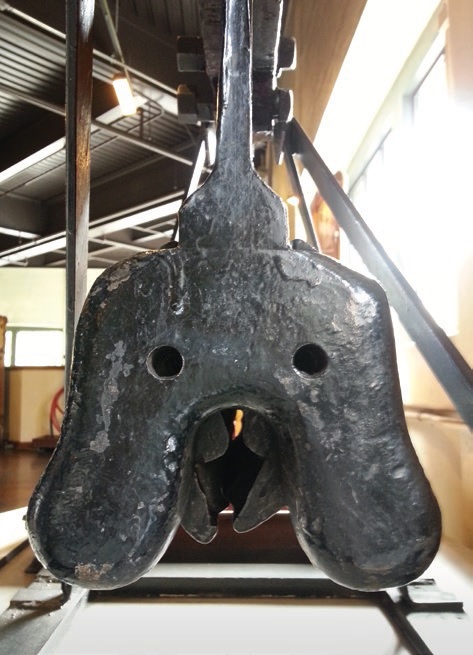Get a grip!
Evan Zabawski | TLT From the Editor April 2018
San Francisco’s cable cars suffer a lot of wear.

Essentially a 311-pound set of pliers, the grip’s jaws exert upward of 30,000 psi to clamp down on the cable forging a temporary connection with a 15,500-pound cable car.
Photo courtesy of Wikimedia Commons. Author: HaeB.
Upon stepping out of The Buena Vista Café, after enjoying one of its famous Irish coffees, I felt the thrum of the cable running under Hyde Street. This cable is one of four 1.25-inch cables moving at a steady 9.5 miles per hour to provide locomotion for the historic and iconic cable cars of San Francisco.
The story is that Andrew Smith Hallidie witnessed a horsecar being pulled up Jackson Street in 1869 when the horse slipped on the wet cobblestones and was dragged to its death. Inspired by this incident and his experience using wire rope cable (of his father’s own patent) for moving iron ore from the mines, Hallidie tested his first cable car on Clay Street on Aug. 2, 1872. One year later, to the day, the Clay Street Hill Railroad began public service.
The basic concept is to have a cable run up and down a length of street; at one end is the powerhouse and at the other it is turned around in a large pulley called a sheave (pronounced
shiv). Cable cars must be able to grip and let go of the cable on demand, thus controlling their motion. The concept is very similar to that of high-speed chairlifts found at ski resorts, albeit pre-dating them by more than a hundred years.
Gripping the cable allows the cable car to be pulled along streets and up hills and also allows for a controlled descent down hills without the need for braking. The main mechanism for gripping the cable is simply called a grip, and the first iteration used on the Clay Street line was a screw-within-a-screw design.
Later design variations are identified as being top grip, side grip or bottom grip. The side grip version was initially quite popular, but twists and turns along newer cable car routes required “let-gos,” which favored the use of a bottom grip style. Let-gos are places where the cable car was required to release one cable and pick up another, needing the attention and skill of the gripman.
The bottom grip style was designed by one of Hallidie’s draftsmen named William Eppelsheimer and is still in use today. Essentially a 311-pound set of pliers, the grip’s jaws exert upward of 30,000 psi to clamp down on the cable forging a temporary connection with a 15,500-pound cable car. Gripping and releasing a moving cable takes its toll on the mild steel dies that contact the cable, and they are replaced every three or four days due to wear.
When performed correctly, the gripman is able to grip the cable without slippage, but if an error occurs the car must roll back down the hill and try again. On some descending curves and when approaching passenger stops, the gripman must release the cable with such timing as to discourage the need for excessive braking. When the cable car must slow down or stop, it can rely on three separate braking systems to ensure this is always possible. The wheel brakes are a simple metal shoe that press against the outside of the wheel; the track brake is a long, wooden (pine) shoe that presses downward against the track; and the emergency brake is an 18-inch-long piece of steel that is dropped into the cable slot until it wedges tight enough to stop the car.
The track brakes wear at nearly the same rate as the grip dies and also are replaced every three days or so. Sometimes smoke can be seen emanating from the track brake, with a distinct smell of burning wood detectable to the passengers. The emergency brakes generate such sudden and sufficient friction that they often require removal from the slot using a cutting torch.
Despite multiple braking systems, it is possible for a cable car to lose control, as it did when it “lost the cable” on Dec. 3, 1967, in the worst cable car accident in San Francisco’s history, right where this tale began. It was reported at the time that all the braking systems were on full, but without the cable they were not strong enough to hold the car on the steep slippery grade, exemplifying the importance of the grip.
Evan Zabawski, CLS, is the senior technical advisor for TestOil in Calgary, Alberta, Canada. You can reach him at ezabawski@testoil.com.